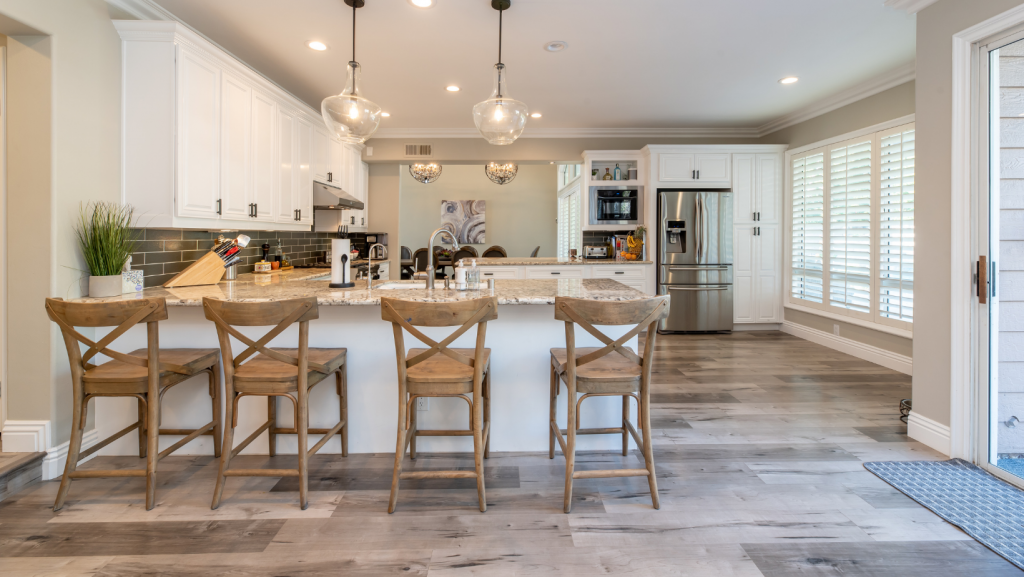
Choosing the right kitchen tile can be a tricky task. You need it to be durable and functional, yet still look amazing and complement your existing (or desired) design aesthetic. And while you want your kitchen to look hip and trendy, you don’t want to pick a trend that will end up on someone’s worst trends of the decade list years down the line.
So, how do you pick the best tile for your San Antonio kitchen? Our guide will show you everything you need to know so that you can choose tile flooring that will last for generations and look good doing it.
Let’s Examine Common Kitchen Tile Materials
If you want to get the best kitchen tile, you need to understand more about the materials most tiling companies use. Each material has its own strong and weak points, so you should inform yourself about each to ensure that you’re getting the right type. Some of the most common materials used for kitchen tile include:
Porcelain Perfection
Porcelain is one of the most durable types of kitchen tile flooring. It can stand up to water and weight well enough for use in commercial kitchens. However, installing it is a tricky process, and the tiles might be too heavy to use if you live upstairs.
Common Ceramic
If you want something resistant to damage and easy to repair if it does break, you’ll want to go with ceramic flooring. Ceramic tile is one of the most common choices of kitchen tile material. It’s mid-range in terms of price, but like porcelain, can be rather heavy. So, if you’re trying to flesh out the second-floor kitchen, ceramic might not be your best choice.
Sturdy as Stone
Stone tiling is very in right now. From luxurious marble to practical travertine, you can find rock-based tiles in many high-end kitchens. However, this material isn’t as resistant to moisture as ceramic or porcelain, and most stone floors will require sealants to keep all the moisture and humidity out. That can make stone tiling an absolute no-go during a stormy, humid San Antonio summer, as our techs will be glad to tell you.
Unless, of course, you like having to reapply sealant all the time.
Stick a Cork on the Floor
One of the latest kitchen tile trends is to use cork-based flooring. It’s been lauded as a comfortable, price-effective, eco-friendly tile option for those on a tight budget that want to help the planet. However, what cork has in affordability and sustainability, it sacrifices in durability. It will require a strong sealant to function well in the kitchen, or else it will become water damaged.
Wooden Floating Tiles
If you’re not the biggest fan of a traditional tile look, but want something more like hardwood, floating tiles can do the trick. These tiles, more often than not, are made from Luxury Vinyl Plank and hover over your existing floor. While they can handle water damage fairly well, they break down more quickly than other materials under foot traffic.
Think of Your Cleaning Process

We’ve covered some of the main materials available. Now, let’s talk about how to choose kitchen tile that you won’t hate within a few years. One important step of this is to consider your typical cleaning process.
How Easily Can the Floor Stain?
You may love that gorgeous white marble kitchen floor now. However, if the sealant doesn’t work perfectly and you ever spill spaghetti sauce on there, you can forget about getting that stain out. Now, there’s a massive orange spot marring your otherwise perfect design.
Will It Show Every Scratch and Footprint?
Certain kitchen tile materials, like glass or lower-quality vinyl, will show every single speck of dust, scratch, and footprint you put onto it. Given how much traffic passes through the kitchen on a regular basis, it’s better to choose a material that resists damage and dust.
Do You Need Special Chemicals to Clean It?
Many people don’t realize until it’s too late that they need a special chemical to clean their floors. This leads to serious damage to what were otherwise pristine tiles. Stone floors are especially picky in this regard, requiring specialized cleaners or pH-neutral solutions to avoid damage.
Do you really want to deal with trying to hunt down a special cleaner every time you decide to clean your kitchen floors? Speaking of…
How Often Do You Clean Your Kitchen Tile, Really?
We won’t judge, but we do ask that you answer this question honestly. How often do you clean your kitchen tile? Certain materials like porcelain and ceramic don’t require much more than a cursory sweep and mop unless they’re really light. However, even those materials can become laden with gunk in a hurry if you don’t clean them on a regular basis.
Consider materials like cork that can be porous even when sealed, and the potential for biohazards to fester in your kitchen floors multiplies, especially when you don’t clean all that often.
If you’re not a fan of cleaning and scrubbing every week, you should consider using a low-maintenance material for your kitchen.
Try to Match Your Cabinetry

Another piece of advice about kitchen tile: Try to make it match your cabinetry. Doing this will give your kitchen a much more unified look, whether you’re remodeling an existing kitchen or designing a brand new one.
Decide early on whether you want your floor to complement or contrast your cabinetry, as this will set the tone for the entire room. If possible, have a sample of the cabinet’s wood when the techs visit or you visit the showroom floor. Trust us, it will make your kitchen feel so much better in the end.
Aim for Durability
Another factor that’s important when selecting kitchen tile is durability. You want your floors to last you for decades, not break under the strain of five years. To that end, you need to consider two major questions:
How Much Traffic Does Your Kitchen Receive?
If you live by yourself and don’t entertain much, your kitchen won’t get as much foot traffic as a family of five. As such, the durability needs of your kitchen will be different from theirs.
If you have a ton of people traversing your kitchen or you stand there a lot yourself, you need to get durable kitchen tiles that can stand up to a lot of abuse. Floating wood and cork floors might not be your best options, there.
Are There Additional Damage Risk Factors?
Second, do you have pets? Small children? Slippery fingers that are liable to drop pots on your ceramic tiles? If you have any of these damage risk factors, you should probably opt for stone or ceramic over glass, cork, or wood.
Make Sure that Tile Is Right for You
Lastly, you should take some time to consider if tile is the best choice for your kitchen floors. It’s not right for everyone. For instance…
Slippery Fingers? Tile Could Cause Problems
Most tile floors tend to be rather hard, especially if you have stone, ceramic, porcelain, or concrete. If you tend to have slippery fingers and tile, you can say goodbye to your dishes once they meet the floor. While most any dish can get damaged from a fall, crashing into hard tile will surely cause it to shatter.
Struggle With Chronic Pain? Tile May Make It Too Hard to Stand
Again, the hardness of tile floors in the kitchen is a boon for their durability. However, if you struggle with chronic pain, especially in the back and joints, it might not be the best option for you. If nothing else, you should probably invest in a few anti-fatigue mats, especially if you tend to spend hours cooking for company.
Never Lose Sight of Your Budget
It’s easy to get sold on a look when you’re shopping for your kitchen remodel. However, you cannot lose sight of your budget in the process. Those gorgeous marble tiles might look perfect in your ideal kitchen, but your wallet has some serious complaints about the price tag.
Keep in mind that your budgeting shouldn’t just account for the initial price of installation and materials. It should also account for maintenance, cleaning, and the cost of potential future repairs. The last thing you want when your floor breaks beneath you is a horrible case of sticker shock once the repairman comes.
Still Not Sure How to Choose Kitchen Tile? We Can Help You Decide!
Choosing the right kitchen tile for your San Antonio home can prove tricky. However, with our guide to kitchen flooring, you now have an idea of the materials you can find. You also should now have a better grasp of the durability and livability concerns of different types of tile. With all this information in mind, you’re sure to make an informed decision.
Has all this talk about kitchen tiles got you looking at your floors wishing for something better? You can check out our Gallery for design inspiration and contact us today to update your floor.




